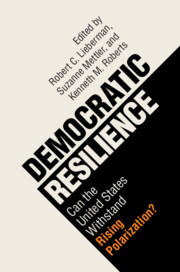Book contents
- Democratic Resilience
- Democratic Resilience
- Copyright page
- Dedication
- Contents
- Figures
- Tables
- Contributors
- Acknowledgments
- Part I Why Might Polarization Harm Democracy?
- Part II Political Institutions in Polarized Times
- 4 Crosscutting Cleavages, Political Institutions, and Democratic Resilience in the United States
- 5 Unilateralism Unleashed?
- 6 Court-Packing and Democratic Erosion
- Part III Social Polarization and Partisanship
- Part IV Vicious Circles? The Relationship between Polarized Behavior and Institutions
- Part V Can Political Action Save Democracy in Polarized Times?
- Index
6 - Court-Packing and Democratic Erosion
from Part II - Political Institutions in Polarized Times
Published online by Cambridge University Press: 20 November 2021
- Democratic Resilience
- Democratic Resilience
- Copyright page
- Dedication
- Contents
- Figures
- Tables
- Contributors
- Acknowledgments
- Part I Why Might Polarization Harm Democracy?
- Part II Political Institutions in Polarized Times
- 4 Crosscutting Cleavages, Political Institutions, and Democratic Resilience in the United States
- 5 Unilateralism Unleashed?
- 6 Court-Packing and Democratic Erosion
- Part III Social Polarization and Partisanship
- Part IV Vicious Circles? The Relationship between Polarized Behavior and Institutions
- Part V Can Political Action Save Democracy in Polarized Times?
- Index
Summary
The ongoing debate about the ills of American democracy features core disagreements about both diagnosis and cure. The title of this book alludes to what is now a multi-decade lament among scholars and pundits focused on US politics regarding the rise of “polarization.” On this account, our problem is that political elites and even ordinary citizens are so divided along partisan lines that they are unable to come together to solve important public problems. Given this diagnosis, the cure would involve institutional changes designed to empower centrists of both parties and to weaken their extremist flanks. Meanwhile, a different group of observers – including students of both democratic procedures in the United States and autocratic governments elsewhere – has diagnosed the problem as partisan degradation rather than polarization. On this account, the key defects facing American democracy are rooted not in a bipartisan refusal to compromise, but in one party’s abandonment of the rules of the game. In other words, these observers trace democratic erosion to the transformation of the Republican Party into an anti-system party.
Keywords
- Type
- Chapter
- Information
- Democratic ResilienceCan the United States Withstand Rising Polarization?, pp. 141 - 168Publisher: Cambridge University PressPrint publication year: 2021
- 4
- Cited by

